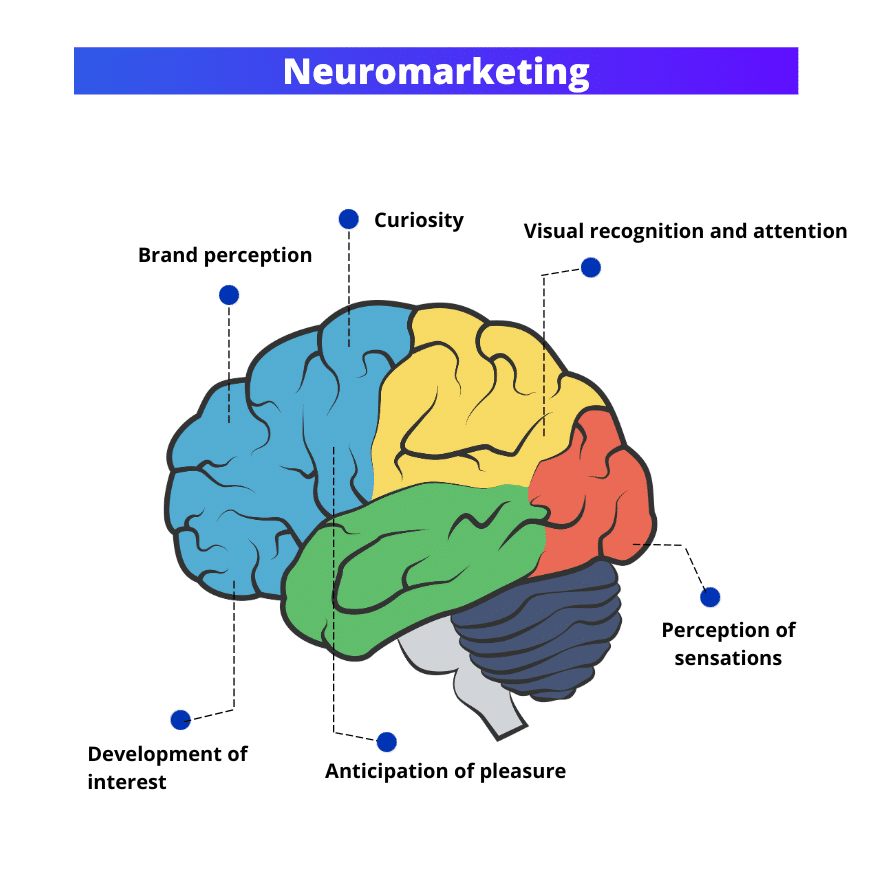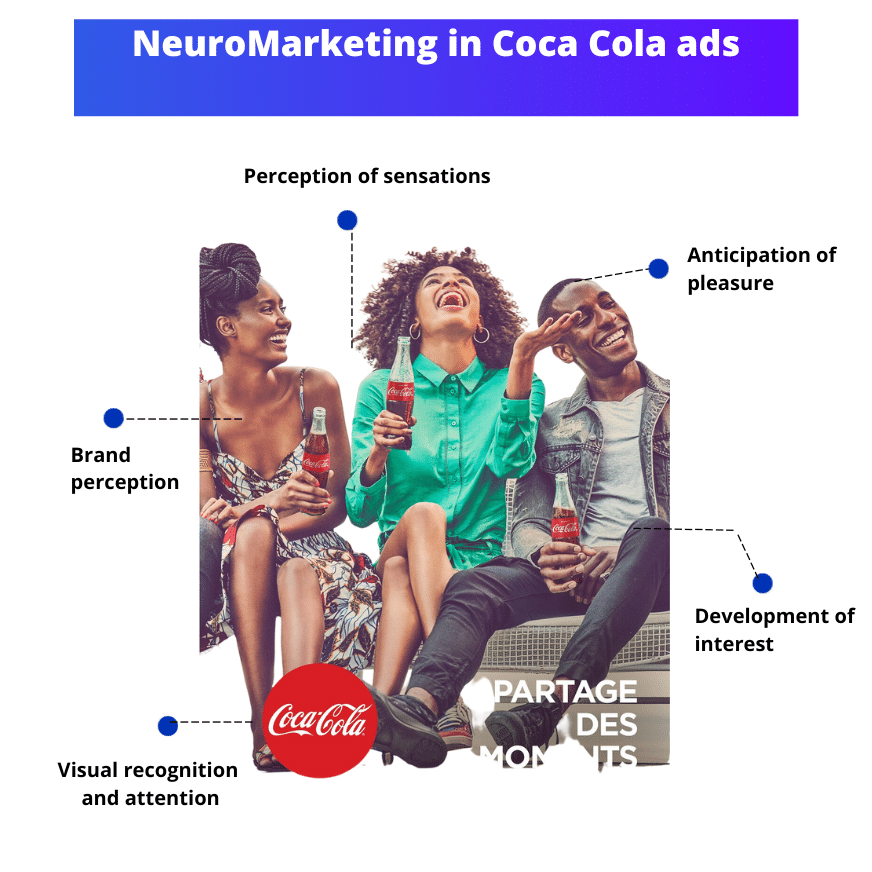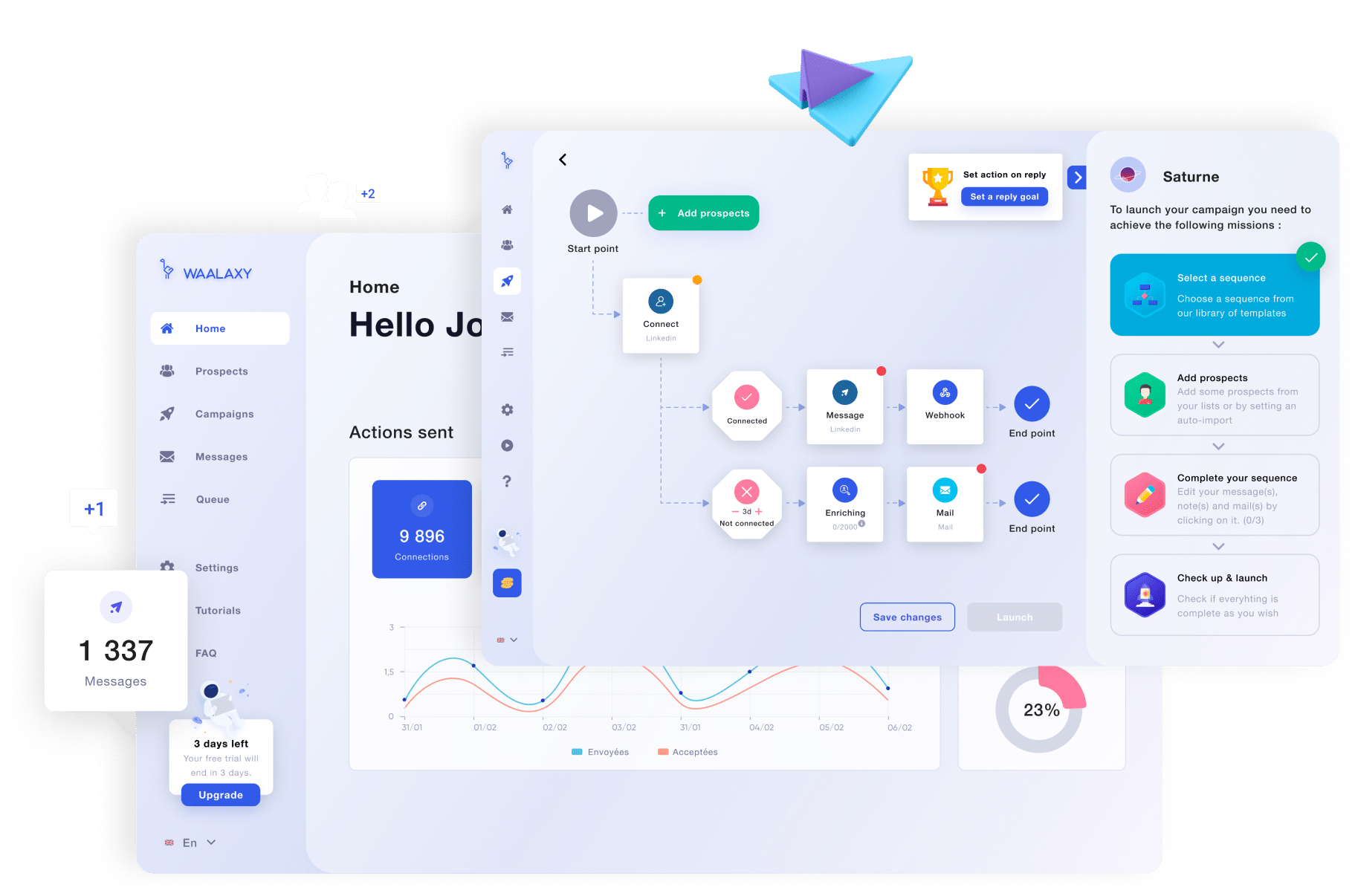Find out more about neuromarketing and discover how marketing draws on the science of the brain to make consumers want to buy a product. 💥
What is Neuromarketing? Definition
Neuromarketing is an approach that uses neuroscience discoveries to understand how people make purchasing decisions. 🤑 Basically, it studies how our brains react to advertisements, products or buying experiences.
It allows companies to create marketing strategies that are more in tune with what’s going on in our heads. 🧠
Neuromarketing, a field at the crossroads of cognitive neuroscience and marketing, offers invaluable insights into the intricacies of human decision-making. By employing techniques such as brain imaging and neuroimaging, businesses can tap into the neural substrates of cognition, psychology, and perception to refine their strategies.
Neuromarketing Examples for a Better Understanding
At the core of neuromarketing lies the study of the human brain. 🤯 The human brain, with its countless neural connections, serves as the epicenter of consumer behavior. Through advanced brain-imaging techniques, we gain unprecedented access to the inner workings of this intricate organ, revealing the neurological processes that shape our preferences and choices.
Explore this small visual to understand how the different parts of the brain influence our purchasing choices, I’ll tell you more a little below. 😉

Special attention is given to the prefrontal cortex, a region critical for decision-making and emotional regulation, offering a window into the factors influencing consumer choices, but sensations and anticipation of pleasure also play their roles in customers’ behaviors. ⚡
Sensations: 🤗
In neuromarketing, sensations play a crucial role in creating memorable experiences. This can mean choosing tactile materials for product packaging or creating pleasant atmospheres in physical shops. For example, soft packaging can really appeal and make people want to try the product. 🛍️
Product design and tactile sensations: 💻
Apple products, like iPhones 📱 or MacBooks, are packaged with impressive attention to detail. They use super smooth, high-quality materials that provide a really nice tactile feel. ✨ When we hold an Apple product, that silky smooth texture activates our sense of touch. 👆
Anticipation of pleasure: 🤩
When you understand how this anticipation of pleasure works, you can design ad campaigns that highlight the good things about a product. Think of an ad where people are having a great time after using the product. That activates the brain’s reward centers and makes consumers want to look into what you’re offering. 🎉
Advertising based on the anticipation of pleasure: 🥤
Coca-Cola is a great example here. Their ads often show us people sharing super fun moments while sipping a can of Coca-Cola. The beaming smiles, sparkling bubbles, and bursts of laughter we see in these ads activate our “pleasure brain”.

It creates a positive anticipation in us, and as a result, it makes us want to take a sip even more. 😊🥤
Other Examples of Neuromarketing in Practice
Example of physical shops: 🛍️
Most shops use neuromarketing, sometimes without even knowing it, to optimize the in-store customer experience.
By using eye-tracking 👀 you can observe where customers focus their attention in the shop. You can use this information to reorganize displays and products, directly improving the effectiveness of the way items are displayed. 💡
Example of e-commerce: 🌐
It’s even easier to integrate neuromarketing on an e-commerce platform because you’ll be retrieving data (data scraping). Using the analysis of behavioral data and user preferences, you’ll be able to offer specific product recommendations to each customer, and therefore increase the chances of conversion and encourage loyalty by offering a more personalized shopping experience. 🚀
How Do You do Neuromarketing?
To do neuromarketing, you need to understand how people’s brains work when they make purchasing decisions, and therefore learn the basics of neuroscience but above all have common sense. 💡
A simple example would be choosing colors for a website or product packaging. 🎁 For example, if you sell products related to relaxation, such as scented candles, soothing tones such as a soft blue or green can create a relaxing atmosphere that attracts customers.
This understanding of neuromarketing can be achieved quickly and simply, using a simple 9-step recipe:
- Understand your audience: 👨👩👧👦 Identify your target group and understand their needs, motivations, and buying behavior. The more you know about your audience, the more you can tailor your neuromarketing strategies. You then need to find participants for your study; they must be part of your target group.
- Define your objectives: ⭐️ Set clear objectives for your neuromarketing campaign. For example, to increase sales, improve brand image, or understand consumer preferences.
- Choose the measurement tools: 📐 Select the appropriate neuromarketing tools based on your objectives. This may include EEG, fMRI, eye-tracking, emotion surveys, etc.
- Conduct studies: 👩🔬 Use neuromarketing tools to measure participants’ responses to the stimulus (click-through rate, number of visitors, etc. depending on what you are trying to measure), then analyze the data to understand emotional and cognitive reactions.
- Interpret the results: 👩🏫 Analyze the data to understand what it reveals about how your stimulus is perceived. For example, if your call-to-action is red, it gets more clicks than if it’s green, you know your target is more attracted to the color. 🔴 Identify strengths and weaknesses.
- Make improvements: 🏆 Use neuromarketing insights to adjust and improve your stimulus. For example, change visual elements, keywords, or colors.
- Implement your strategy: 🚀 Incorporate the changes into your marketing campaign or product based on the insights from the neuromarketing study.
- Monitor and evaluate: Monitor the performance of your campaign using relevant metrics, such as sales, brand awareness, etc. This allows you to adjust your approach if necessary.
- Repeat: 🤩 If necessary, repeat the steps as your market or marketing objectives change.
Types of Neuromarketing Techniques
Cognitive neuroscience, a discipline that explores the neural mechanisms underlying cognition, forms the foundation of neuromarketing.
Drawing from psychology and neuroscience research, we uncover the secrets of how consumers process information, make decisions, and respond to marketing stimuli. ✅ This convergence of disciplines empowers businesses to craft targeted campaigns that resonate with their target audience.
In this section, I briefly explain what types of neuromarketing studies you can conduct, depending on your objectives. 🚀
1. Neuromarketing Study of Brain Activity
This is a fairly difficult study to set up as it requires cutting-edge equipment. The best way to carry out this type of study is to have volunteers carry out the tests and to be in partnership with a study center. 🤓
There are several tools and methods available:
- Electroencephalogram (EEG): Measures the electrical activity of the brain. This is useful for understanding consumers’ emotional and cognitive responses to marketing stimuli, so you can understand what emotions your products, services, or advertising provoke. 📣
- Functional magnetic resonance imaging (fMRI): Provides information on the areas of the brain activated in response to marketing stimuli. This makes it possible to target specific regions linked to emotions and purchasing decisions, meaning that you can understand which areas of the brain are activated when people test your product, see your ad, etc. 🗣️
2. Physiological Responses in Neuromarketing
In these cases, you’ll need a few tools to carry out the tests, but they’re more accessible than measuring brain activity. You can hire heart rate machines, for example:
- Heart rate: 🫀 Measures variations in heart rate in response to marketing stimuli. Can indicate excitement or stress.
- Facial recognition software: 👶 Identifies participants’ emotional expressions by analyzing facial movements, to give you insights into immediate emotional reactions.
3. Customer Emotion Surveys
Easier to set up, customer emotion surveys 😻 can be carried out using several marketing methods:
- Emotion rating scales via a questionnaire: this allows participants to rate their emotional responses to adverts, products, or shopping experiences.
- Qualitative interviews: offer a space for test participants to express themselves freely about their emotions, providing rich and nuanced information. 🌈
4. Visual Reaction Survey
- Visual eye-tracking: 👀 Tracks eye movements to determine which parts of an image or web page capture attention. This helps optimize the placement of key visual elements in an advertisement or on a website.
- Heatmaps: Visually show the most viewed areas of an interface 🔥 it helps you design more effective visuals and layouts.
5. Implicit Association Tests and Online Behavior Analysis
- Rapid response methods: measure test participants’ automatic, unconscious responses to stimuli, allowing you to understand emotional associations linked to a brand or product. 👉 For example, if you put up two displays and ask them to click where they are most attracted, it must be quick.
- Analysis of activity on social networks: Allows you to understand consumer reactions to online campaigns and content.
- Click and navigation analysis: Reveals user behavior on a website 💻 which helps optimize the customer experience.
By combining these tools, marketers can gain an in-depth understanding of consumers’ emotional and cognitive reactions, helping them to design more effective and engaging campaigns and experiences. 🧲
The last 3 types of surveys are the most common and widely used studies, the ones I recommend you start with if you’ve never done neuromarketing before. 🫶
Conclusion on Neuromarketing
Neuromarketing may sound a bit learned, but in reality, it’s simple. 👌 There are several methods that can be applied without any special tools, and other more advanced methods that require you to create partnerships. What you really need to carry out these tests is a sample of participants who correspond to your target.

In this section, we try to answer as many of your questions as possible. 👇
FAQ of the article
How does Neuromarketing Differ from Traditional Marketing Methods?
Neuromarketing goes beyond surveys and data analysis. 🔢 It uses techniques such as EEG, fMRI, and eye-tracking to understand consumers’ unconscious reactions, offering deeper and more accurate insights.
How can Neuromarketing Influence Consumers’ Purchasing Decisions?
By understanding brain responses, neuromarketing can optimize messages, visuals, and shopping experiences to evoke positive emotions and strengthen the connection between product and consumer.🫶
Is Neuro-Marketing Applicable to all Companies?
Absolutely. 💯 From food to fashion to technology, 📲 neuromarketing can be adapted to understand and influence buying behavior in various markets.
Does this Practice Respect Consumer Privacy?
Yes, neuromarketing studies are generally conducted ethically and anonymously. 🤫 Individual data is not divulged and is used solely for analysis purposes, unless you have ticked the small “share with our partners” line. 😉
How can I integrate Neuro Marketing into my Current Marketing Strategy on my Blog?
Start by choosing the neuromarketing tools that match your objectives and are simple to implement, such as the heatmap or rapid reaction analyzes. 🎯 Then conduct research to understand how your audience reacts. Use these insights to adjust your customer experience and improve the customer experience.
Is it Accessible to Small Businesses with limited Budgets?
Yes, many neuromarketing methods can be adapted to different budgets. 💰 From emotion surveys to preference testing that will tell you next to nothing, there are affordable options to gain valuable insights without putting a dent in your business revenue.🫣
What are the Long-term Benefits of Neuromarketing for a Business?
Neuromarketing provides a deeper understanding of customers, 🧠 leading to more effective campaigns and encouraging customer retention. In other words, sustainable growth and greater competitiveness in the marketplace!
What’s the next Big Trend in Neuromarketing?
The integration of artificial intelligence and machine learning into neuromarketing data analysis promises to bring even more advanced levels of analysis and personalization 🧠. Find out more about AI here!
What’s Neurobiology?
Neurobiology, the study of the nervous system and its constituent neurons, provides critical insights into the mechanisms that underlie consumer preferences. 👍 By examining how neurons communicate and form neural networks, businesses gain a deeper understanding of the neural basis of consumer behavior.
Is Neuro Marketing Completely Replacing Traditional Marketing Methods?
No, 🧐 it complements traditional methods by providing deeper insights into consumer reactions, it’s thanks to the results of neuromarketing studies that we then adapt the marketing strategy, not the other way around. The two approaches can therefore work together to boost the effectiveness of marketing campaigns.
By leveraging the power of neural insights, businesses can forge deeper connections with their customers, ultimately driving growth and success. And there you have all the knowledge to do so, thanks to this neuromarketing guide! 🔥








